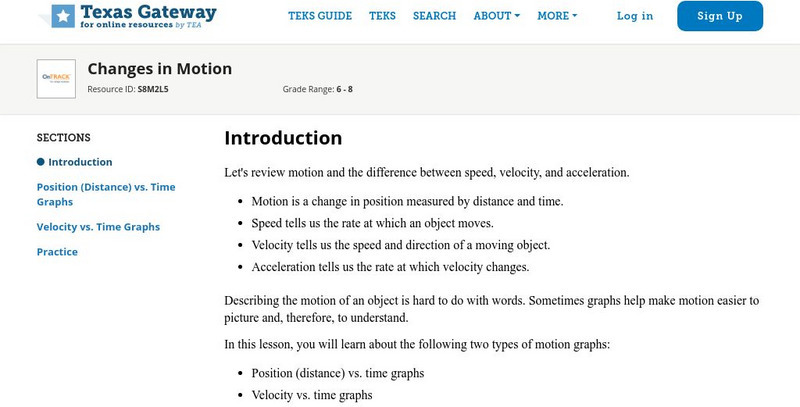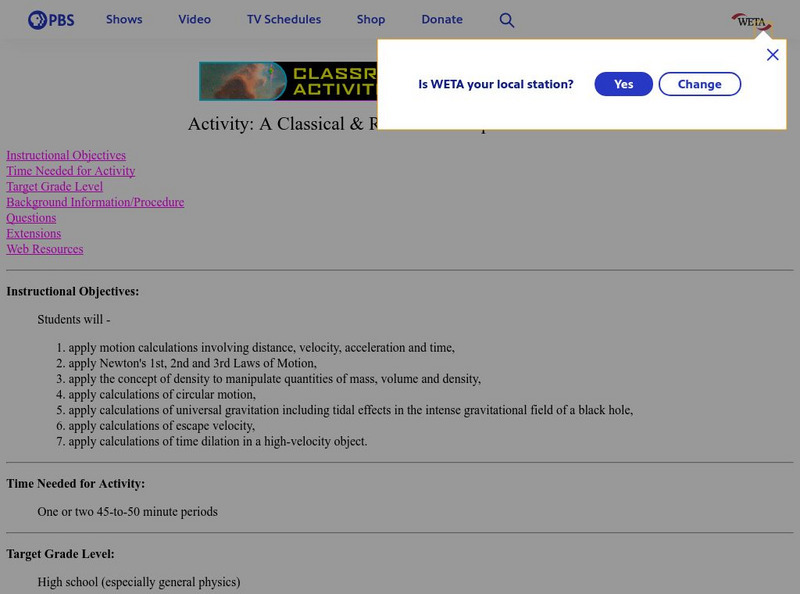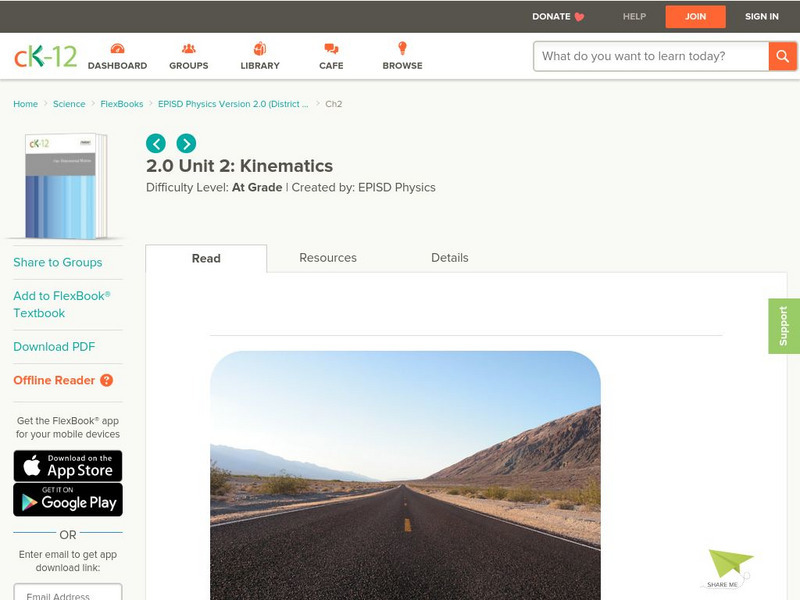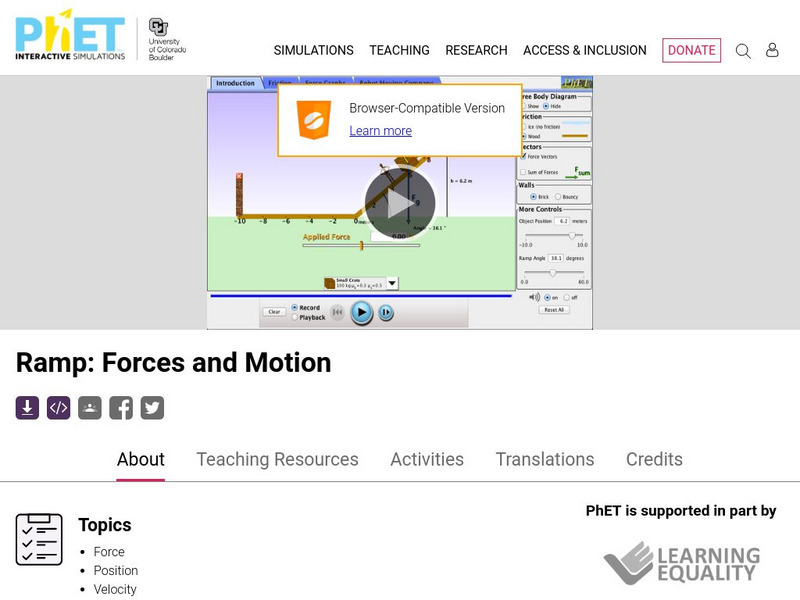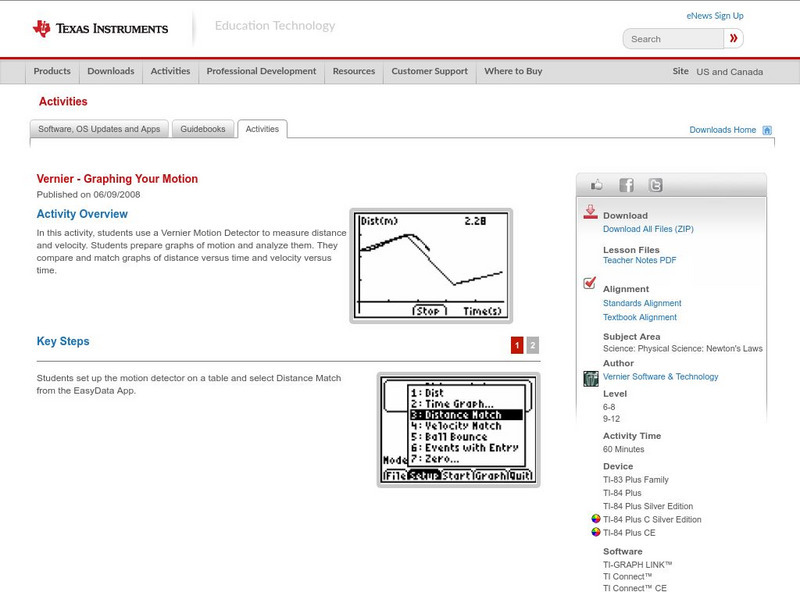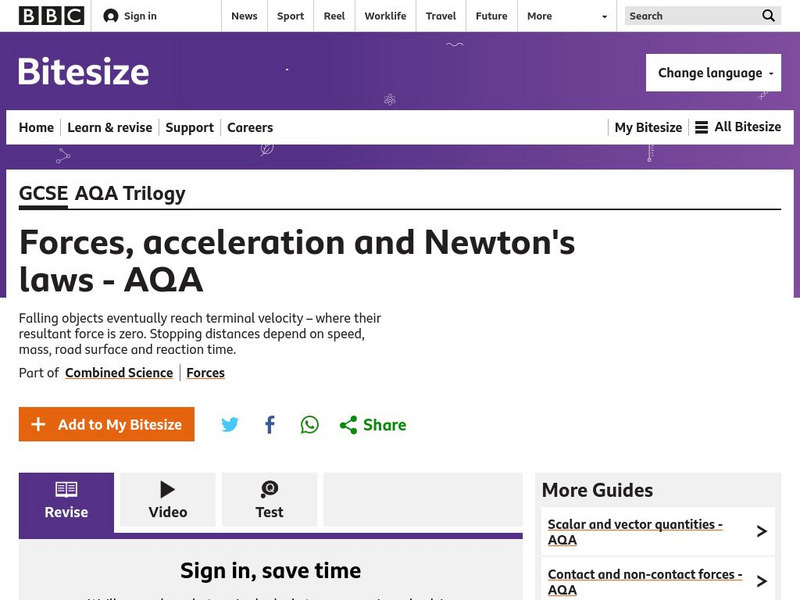Hi, what do you want to do?
Science Education Resource Center at Carleton College
Serc: Investigating Motion Graphing Speed
In this introduction to motion activity, learners will get a personal understanding of speed and acceleration by experiencing it firsthand. Wheeled office chairs or other cart like devices are used to give one student a ride as a fellow...
Texas Education Agency
Texas Gateway: Introduction to Motion
What do you think of when you hear the word motion? Are you moving right now? You may not think so, but you are. Remember, the Earth is moving around the Sun, and the Sun is moving around the Milky Way Galaxy. Everything in the universe...
TeachEngineering
Teach Engineering: Projectile Motion
Students are introduced to the concept of projectile motion, of which they are often familiar from life experiences,such as playing sports such as basketball or baseball, even though they may not understand the physics involved. Students...
Physics Aviary
Physics Aviary: Circular Motion Learning Lab
This lab/learning activity is designed to introduce students to some of the basic terms with circular motion. They will be introduced to rpm, frequency, period, angular frequency, speed and velocity. It is hoped that students will be...
Texas Education Agency
Texas Gateway: Changes in Motion
In this lesson, you will learn about position vs. time graphs and velocity vs. time graphs and how to use them to solve problems.
Physics Aviary
Physics Aviary: Motion Graph Matching
You will be given a velocity vs. time graph for the motion of a car. Your job is to match the graph with your car by pushing on the gas or brake or coasting at the appropriate moments. Before you start the matching game, you must set the...
Physics Classroom
The Physics Classroom: 1 D Kinematics: Acceleration vs. Constant Velocity
Observe the animation of the three cars. Use the animation to answer three questions about their acceleration and velocity.
PBS
Pbs: A Classical and Relativistic Trip to a Black Hole
This PBS site is a classroom activity that takes a trip to a black hole. Students apply calculations on distance, velocity, acceleration, time, circular motion, density, and more.
Georgia Department of Education
Ga Virtual Learning: Linear Motion
A learning module where students gain an understanding of the relationships between the different kinds of motion. Students will be able to explain free-fall motion and use kinematics equations to calculate problems involving falling...
Physics Aviary
Physics Aviary: Velocity Vector in 3 D
A program that will randomly move an object from one location to another in three-dimensional space. You must determine the three components of the velocity vector that is created by this movement and also the speed of the object during...
Physics Classroom
The Physics Classroom: Describing Motion With Words
This lesson from the Glenbrook South High School gives a nice review and detailed explanation of velocity, speed, distance, displacement, and acceleration. A good introduction to the "language of Kinematics."
CK-12 Foundation
Ck 12: Episd: Physics: Kinematics
[Free Registration/Login may be required to access all resource tools.] An online chapter focused on motion and the shapes it takes. Topics range from speed and velocity to acceleration and free fall. Find detailed visuals, learning...
Texas Education Agency
Texas Gateway: Circular Motion & Gravitation: Rotation Angle & Angular Velocity
By the end of this section, you will be able to define arc length, rotation angle, radius of curvature, and angular velocity; and to calculate the angular velocity of a car wheel spin.
Texas Education Agency
Texas Gateway: Speed, Velocity, and Acceleration
Given descriptions, illustrations, graphs, charts, or equations, students will differentiate between speed, velocity, and acceleration.
University of Colorado
University of Colorado: Ph Et Interactive Simulations: Ladybug Motion 2 D
Learn about position, velocity, and acceleration vectors by moving the ladybug. Set the position, velocity, or acceleration, and see how the vectors change.
Texas Education Agency
Texas Gateway: Types of Motion
Students will distinguish between and/or interpret the types of motion.
Texas Education Agency
Texas Gateway: Changes in Motion
Given diagrams or scenarios, students will measure and graph changes in motion.
University of Colorado
University of Colorado: Ph Et Interactive Simulations: Ramp: Forces and Motion
Explore forces and motion as you push household objects up and down a ramp. Lower and raise the ramp to see how the angle of inclination affects the parallel forces.
Science Education Resource Center at Carleton College
Serc: Motion: Investigating Motion Graphs
In this lesson, students investigate motion graphs. Students predict what the distance-time graph and velocity time graph would look like for a student walking across the room for three different scenarios.
Texas Instruments
Texas Instruments: Graphing Your Motion
In this activity, students use a Motion Detector to measure distance and velocity. Students prepare graphs of motion and analyze them. They compare and match graphs of distance versus time and velocity versus time.
BBC
Bbc: Gcse Bitesize: Motion
This lesson focuses on how to calculate average speed and distance traveled. It also explains how to convert different units of measure and provides a link to an assessment.
BBC
Bbc: Gcse Bitesize: Forces, Acceleration and Newton's Laws Aqa
This lesson focuses on Newton's First Law: an object remains in the same state of motion unless a resultant force acts on it. If the resultant force on an object is zero, this means: a stationary object stays stationary; a moving object...
Physics Classroom
The Physics Classroom: 1 D Kinematics: Scalars and Vectors
This illustrated tutorial focuses on several examples of vector and scalar quantities including distance, displacement, speed, velocity, and acceleration.
CK-12 Foundation
Ck 12: Wave Speed Calculations
[Free Registration/Login may be required to access all resource tools.] Students investigate and analyze characteristics of waves, including velocity, and calculate the relationship between wave speed, frequency, and wavelength.









